MobiNet - The interface (v1.1)
Networked platform for mobiles programming.
In MobiNet, one programs the behavior of various mobiles: These are the various visible objects (whether they move or not!). The interface allow the tuning of every behaviors of the current mobile: aspect, motion, colliding rules with borders or other mobiles... (then one switch for a mobile to the other).
![]() General aspect of the screen (click for zooming).
The various areas are described below.
General aspect of the screen (click for zooming).
The various areas are described below.
Here, we programmed 7 mobiles: the ball, the racket, the goals, the
counters.
- The ball follows a straight line trajectory, and bounce on borders
and on the rackets.
- The rackets follow the mouse vertically.
In facts, one of the rackets (and the corresponding goal and counter)
is managed by another computer: here, two users share their mobiles
on the network. One manage the reds and the ball, the other manage the
blues.
- The goals account for collisions with the ball, and trigger the
opposite counter.
- The counters increment when triggered by the goals.
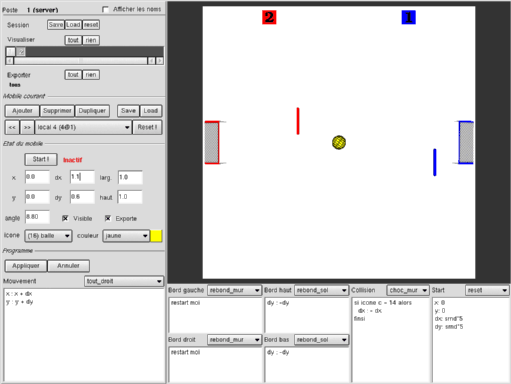 .
.
![]() By clicking on `display names', one can see the mobiles number
(local n when managed on the computer, n@m when
managed by computer m)
and the coordinate system (-100 to 100 for x and y).
By clicking on `display names', one can see the mobiles number
(local n when managed on the computer, n@m when
managed by computer m)
and the coordinate system (-100 to 100 for x and y).
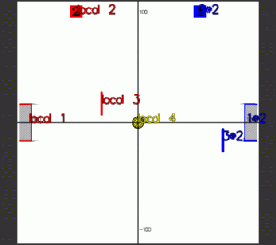 .
.
![]() Parameters describing the current mobile (here, the ball):
position, dimension, icon, color, orientation...
(moreover, we will use dx,dy to encode the motion direction.)
Parameters describing the current mobile (here, the ball):
position, dimension, icon, color, orientation...
(moreover, we will use dx,dy to encode the motion direction.)
NB: in fact all is number (e.g. the ball icon is number 16),
which allows calculation.
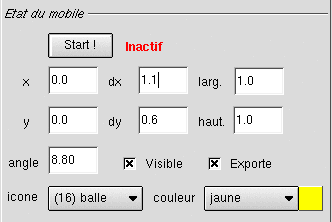
![]() Programming the motion: it consists in describing the changes to be
done between 2 images (about every 25th second)
by "such_parameter: new_value".
See the language manual
for the set of usable commands in the program areas.
Programming the motion: it consists in describing the changes to be
done between 2 images (about every 25th second)
by "such_parameter: new_value".
See the language manual
for the set of usable commands in the program areas.
One can set small iterated steps (`dynamics'),
describe a function of time (`cinematics'), or of the mouse,
or of the position of the other mobiles (e.g. chasing),
or any combination programmed according to once fantasy.
(NB: predefined sets of behaviors are also available to pick up
ingredients if wanted. These presets are stored in a text file,
so an teacher can easily modify them.)
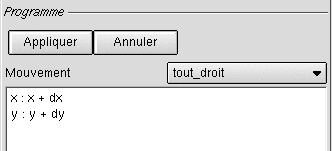
![]() What to do when a mobile touch a border.
What to do when a mobile touch a border.
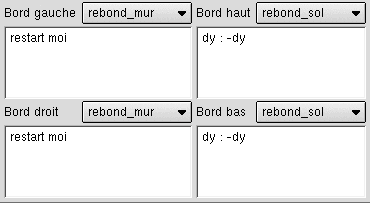
![]() What to do when a mobile touch another mobile.
What to do when a mobile touch another mobile.
If necessary, one can settle a different behavior, depending on the
collider identity.
(e.g.: if collider's icon is a racket then...)

![]() Parameters value when (re)starting.
Parameters value when (re)starting.
NB: a mobile can ask to restart itself (e.g. in case of collision) or
to restart another mobile (e.g. to trigger a counter, a shot, to kick-off the ball...)
using the command restart num.
It is also a way to send messages between mobiles.
(srnd gives a random number between -1 and 1.)
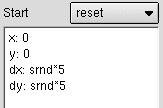
![]() Creating a new mobile, choosing the current one, etc.
Creating a new mobile, choosing the current one, etc.

![]() Resulting display.
Resulting display.
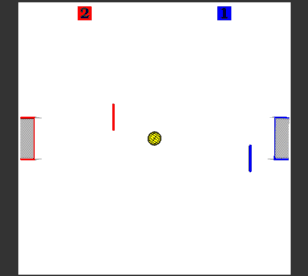
![]() Reading, writing, interacting with other computers through the network...
Reading, writing, interacting with other computers through the network...
One chooses the mobiles to be exported (i.e. that one make
visible on the network) and the computers whose we import the mobiles.
Thus, several working modalities can be used:
- independent work on each station.
- displaying any station from a master station.
- displaying every station superimposed (e.g. pour wall projection).
- collaborative work by groups if 2 or 3 stations (or more).
- collaborative work between N stations (not necessarily on the
local network).

![]() That's it ! Quite easy, isn't it ?
That's it ! Quite easy, isn't it ?
|
|